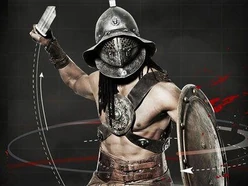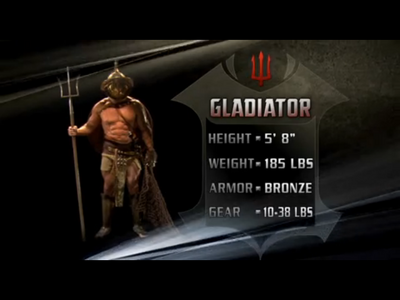| Gladiator | |
|---|---|

| |
| Weapons | Cestus, Scissor, Trident & Net, Sling, Sica |
| Origin | Ancient Rome |
| Activities | Fighting other Gladiators and animals |
| Service | Ancient Rome |
| Battle Status | Lost vs. the Apache |
| Experts | Chris Torres (Weapons Specialist) Steven Dietrich (Combat Instructor) Chuck Liddell (UFC champion) |
"The Gladiator lived only for one thing, and that is to kill." -Chris Torres, Ancient Weapons specialist
The Gladiator, proud, thrilling killer of Ancient Rome.
The Apache, fierce, scalp-taking master of death.
Stats
- Height - 5'8
- Weight - 180 lbs
- Armor - bronze
- Gear - 10 - 38 lbs
- Symbol - Trident (signature weapon of Gladiator)

Gladiator Symbol
History
Gladiators were either captured soldiers from rival armies, condemned criminals selected for their ferocity, strength and skill, or very rarely free people who chose to fight. In Ancient Rome, gladiators entertained the public with deadly and bloody battles to the death. Lanista were nobles responsible for housing and coaching the Gladiators.
To ensure the best spectacle, Gladiators were trained in the art of killing, using a wide-range of lethal, crowd-pleasing weapons. Those who survived became legendary heroes.
In gladiatorial combat, gladiators were expected to die without asking for mercy or crying out in pain. If a defeated gladiator had fought courageously and won over the crowd's sympathy, his life would be spared. It is unknown what the death rate for defeated gladiators was, but it is usually assumed that most gladiator's careers lasted less than ten fights. Winners would often receive laurel wreaths or money from the crowd, but the greatest gift was his freedom, symbolized by receiving a rudis (wooden training sword).
Upper-Class Romans would often drink the blood of fallen Gladiators. The winning gladiator would have a bath in olive oil and then the sweat,blood, and dirt mixed with the olive oil would be sold for high money for upper class romans to drink (commonly men).
As the Roman Empire fell into poverty and Christianity (a religion that preached pacifism and was strictly against blood-sports) became more popular, Gladiators eventually became outlawed in 438 AD.
Tournaments and duels existed in several warrior cultures around the world. For example jousts for Knights.
Weapons
| Weapons | Gladiator | Kills |
|---|---|---|
| Close Range: | Cestus Scissor |
50 50 |
| Mid Range: | Trident & Net | 166 |
| Long Range: | Sling | 1 |
| Special Weapons: | Sica | 116 |
Battle:
As the battle starts, the Apache warrior and the Gladiator are seen walking towards each other in a grassy field. The Gladiator makes a battle cry and raises his Trident, continuing his advancement toward the Apache. The Apache pulls out his Bow and Arrow and fires at the Gladiator, but hits his shield. The Gladiator readies up his Sling and hurls a stone at the Apache, who effortlessly dodges it. The Apache fires another arrow at the oncoming Gladiator and successfully hit him in the side of his stomach. The Gladiator pulls out the arrow and yells in anger, surprising the Apache. The Apache tries to run away as the Gladiator throws another stone with his sling. The stone once again misses, and the Apache tries to fire another arrow. When this fails, he further retreats into the trees. The Gladiator quickly catches up, however, and brings out his Trident and Net. The Apache tries to block with his shield, but it is thrown aside by the Gladiator's trident. The Apache pulls out his Tomahawk and swings at the Gladiator, but hits his manica. The two get into a struggle, with the Gladiator gaining the upper hand and kicking him to the floor. The Gladiator advances with his trident while the Apache tries his hardest to avoid the weapon. The Apache tries to get the trident stuck in a tree branch, but the Gladiator quickly frees it and continues to attack the Apache. With few options left, the Apache tries to make a run for it. The Gladiator, however, responds quickly and throws his net, tripping and ensnaring the Apache. The Gladiator throws the Trident at the Apache, but the Apache just barely rolls out of the way. He frees himself from the net and throws his tomahawk, which sails past the Gladiator's helmet. The Gladiator pulls out his Sica, and the Apache pulls out his War Club. The Gladiator tries to stab the Apache with his sword, but the Apache knocks it out of his hand with the club. He swings again and completely knocks off the Gladiator's helmet. The Gladiator pulls out his shield and brushes off the arrow from earlier on. The Apache runs charges at the Gladiator and tries to jump and strike his head with the club. However, he mistimes his jump and slams straight into the shield, sending him to the floor. The Gladiator kneels down and begins punching him in the face with the Cestus. He goes to retrieve his sword, but turns to see that the Apache has drawn his Knife. He tries to punch him with the Cestus, but misses. In a last desperation, the Gladiator swings his shield at the Apache, but the Apache ducks and slices at the Gladiator's hamstrings. He slices across the Gladiator's chest, then gets up and stabs him in the back. The Gladiator falls to his knees and the Apache closes in and slits the Gladiator's throat. The Gladiator falls to the floor, and the Apache stabs him in the head to make sure he is dead. The Apache gets up and licks the blood off of his knife. He yells a prolonged victory cry, then runs away, leaving his fallen opponent behind.
Expert's Opinion:
Despite the fact that the Gladiator fought everyday for the sake of his life, the Apache's weapons dual close and mid range capability won out. Each close range weapon being an equally effective mid range throwing weapon. The Gladiator's lack of armor in particular gave the Apache another advantage. In both a open flatland (which is what Gladiator arenas are similar to) and a light forest (where Apaches are used to) the Apache could use his projectiles and melee weapons easily.
Trivia
- The gladiator depicted in the final battle is a combination of various different classes of gladiators: his armor is that of the murmillo, while his weapons (with the exception of the cestus and sling) are taken from the secutor or Scissor, Retarius, and Thraex classes.
- Many slave revolts in Rome were lead by the Gladiators, who fought against Roman armies for their freedom. Rarely would a Gladiator use a sling inside the ring, but they were popular with the Gladiator rebels. This is shown in the episode with a Roman Centurion ambushed by a Gladiator rebel. One of the most notable gladiator-lead rebillions was the armed slave revolt lead by the gladiator Spartacus.
- Knights fought in tournaments designed to train them, these tournaments acting similar to Gladiator fights but with full armor. As it was training, warriors would avoid killing each other, but fatalities did occur, forcing new rules in the tourneys. And like Gladiator fighting, these tournaments attracted large crowds.
- Contrary to popular belief, death matches were actually rare: only 10% of matches ended in a fatality. It was unpopular for Emperors to demand a battle to the death: such an action could cause a political backlash. Gladiators were normally too valuable as celebrities to risk having them killed. For the majority of Gladiatorial history: intentionally killing another Gladiator was against the rules. Emperor Augustus was the first to strictly forbid killing of any kind.
- Other rules included; no eye gauging, no headshots from behind, and no intentional crotch shots.
- Like modern boxing; Gladiators had umpires to maintain the rules of the duels. Also like boxing; Gladiators were not allowed to attack a Gladiator that fell to the ground, until that Gladiator stood up again and the match officially resumed.
- Gladiators could declare a surrender by pointing their finger in the air.
- The exceptional diet and medical care of Gladiators allowed the average Gladiator to fight in about 40 battles before retirement.
Gallery
